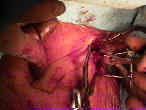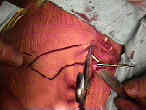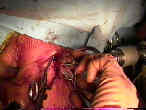- Discussion:
- note that the main pitfall of this procedure is getting the pin incarcerated within the lateral clavicle;
- if the pin does become incarcerated, then attempts to extricate it may result in hardware failure;
- the intramedullary canal of the lateral fragment is reamed (using the same drill as was used for the medial fragment);
- be sure to reinsert the drill across the intramedullary canal several times in order to be sure that the drill passes without difficulty;
- the drill is advanced thru the lateral end of the clavicle (posterior and medial to the AC joint), and is further advanced until the drill tip is palpable beneath the skin;
- as the pin is being driven laterally thru the posterolateral cortex of the clavicle, be carefule to withdrawl the pin back and forth several times to ensure that it does not become incarcerated;
- once across the cortex, the pin is driven laterally until it tents the skin;
- a knife is then used to make a 1 cm incision, to allow the pin to exit;
- the drill is then applied to the lateral pin tip, and the pin is pulled laterally until it is completely lateral to the fracture site;
- again, care is taken to ensure that the lateral pin threads do not become entrapped in the lateral clavicular cortex





- note that the main pitfall of this procedure is getting the pin incarcerated within the lateral clavicle;
- if the pin does become incarcerated, then attempts to extricate it may result in hardware failure;
- the intramedullary canal of the lateral fragment is reamed (using the same drill as was used for the medial fragment);
- be sure to reinsert the drill across the intramedullary canal several times in order to be sure that the drill passes without difficulty;
- the drill is advanced thru the lateral end of the clavicle (posterior and medial to the AC joint), and is further advanced until the drill tip is palpable beneath the skin;
- as the pin is being driven laterally thru the posterolateral cortex of the clavicle, be carefule to withdrawl the pin back and forth several times to ensure that it does not become incarcerated;
- once across the cortex, the pin is driven laterally until it tents the skin;
- a knife is then used to make a 1 cm incision, to allow the pin to exit;
- the drill is then applied to the lateral pin tip, and the pin is pulled laterally until it is completely lateral to the fracture site;
- again, care is taken to ensure that the lateral pin threads do not become entrapped in the lateral clavicular cortex






